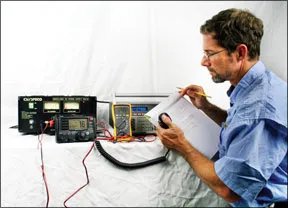The fixed-mount marine VHF radios Practical Sailorreviewed this go round go way beyond the basic capabilities of the more moderately priced gear featured in our February and April 2009 issues. These units include features like an integral high-wattage hailer, multiple remote microphone connections, and the capability to store many Maritime Mobile Service Identity (MMSI) numbers and inbound Digital Selective Calling (DSC) data. Bonus capabilities inherent in these top-of-the-line radios include the ability to act as part of an intercom system, to display vast amounts of navigation data, and to produce automated fog signals at the touch of a button.

Taking advantage of all the features found in these best-of-breed units often requires purchasing additional equipment (as well as the obvious antenna). First, navigation data must be supplied by an onboard GPS/chartplotter capable of outputting NMEA 0183 data. To set up an intercom system, users will need to add a remote microphone, and to use the hailer and foghorn, a hailer horn must be installed. The radio itself ends up being the base for building a communications system, and buyers could spend hundreds more to fully capitalize on the capabilities of one of these multi-function marine VHF radios.
With these radios, you get plenty of bang for your buck, but sailors who rarely use the bells-and-whistles features would be served just as well with one of the mid-priced or low-end radios we reviewed in the April and February issues. If youre in the market for a primary VHF with excellent audio quality and have the budget for the bonus features, consider one of the following radios. But if youre a serious offshore cruiser and money is tight, we suggest looking closely at a third option: Buying two budget-friendly VHF radios, one to wire to a mast-top antenna and the other to a stern-rail antenna. This setup can provide an added layer of security for about the same price as one of the high-end units reviewed here.
What We Tested
Five radios made up this top-of-the-line, fixed VHF test group. From well-known Japanese electronics manufacturer Icom, we tested the M504 and M604 models. From Standard Horizon, we evaluated the GX5000S and GX5500S. We also tested the most expensive and sophisticated VHF from British marine electronics manufacturer Raymarine: the 218 model. Prices ranged from $300 to $500 per test radio.
One feature common among the radios is their designation as meeting international Class D standards for DSC functions. Class D means this radio has two separate receivers, one for voice communications and the second for continuously monitoring channel 70 for any DSC calls. (See “FAQ on DSC” on page 17.)
They also all come with three-year warranties; operate on U.S., international, and Canadian channels; and meet the IPX7 waterproof standard or better, which means they will survive being sunk to 1 meter for 30 minutes. The Icom M504 actually is rated IPX8, or 1.5 meters for 30 minutes.
Only two VHFs in this test field feature alphanumeric keypads: Icom M604 and Standard Horizon GX5500S. Having a keypad makes using the DSC features much easier as entering contact MMSI numbers and call data is faster with a keypad. We divided the field into keypad haves and have-nots for final rating purposes. All of these radios can be paired with compatible remote mics.
The Raymarine was the only test product without an optional voice scrambler, and all of the test radios feature automatic fog signals via a hailer.

How We Tested
Following the same procedures used in Practical Sailors previous VHF comparisons, testers evaluated each radios audio and transceiver performance in a series of bench tests using a Ramsey COM3010. Transmitter power output, frequency accuracy and stability, and receiver sensitivity were among the tests conducted. We also considered features, user-interface, price, and warranty.
Any data derived from “real world” tests of radio frequency power output are of limited use, since so many factors-environmental conditions, antenna size and design, connecting cable length and type, and faulty connections or corrosion-can affect performance. The Federal Communications Commissions regulations limit the maximum power output of a marine fixed-mount VHF transmitter to 25 watts. The rules also specify the need for a low-power setting, typically 1 watt, for harbor use.
Transmitter power stability was determined by gathering data from a range of tests including performance after exposing the radios to extreme high and low temperatures. The less variation in power output we noted, the higher the rating. Testers also measured frequency accuracy and frequency stability. The closer to the selected frequency a transmitter stayed, the higher it rated. Amperage draw was recorded at high power and low power at both 13.8 and 11.0 volts DC.
A standard test for receiver sensitivity is used to determine a radios ability to receive weak signals. Industry groups recommend a minimum of .50 microvolts. (Lower numbers indicate more sensitivity.) All the radios we tested surpassed the standard, and were more than sensitive enough to pick up very weak incoming signals. The Value Guide lists manufacturer specifications: a higher number is better.
Testers rated the displays based on size, quality of information, and backlighting. The radios audio systems were evaluated by measuring sound pressure in decibels (dBa) 1 meter from each radio while it was set at max volume. The input sound for this test was a 1-KHz tone. Testers also monitored a weather channel and rated the quality of sound reproduction. We also gave each radio a features rating based on the level and usability of the bonus functions beyond the basic transmit and receive.

Product photos by Al Herum
Icom M504
At the low end of the price range among these top-of-the-line radios, the $300 Icom M504 is also the smallest in the group. Overall, the Icom M504s performance was ranked very highly, with one caveat: Audio output. It managed only 86 decibels.
Its front panel houses numerous function pushbuttons, a large display, and control knobs for volume, squelch, and channel/menu selection.
The M504 features one-button controls for power, intercom, weather channels, transmitter power output, and receiver attenuation (distant or local reception). In a congested harbor with lots of radio traffic, a receiver can be overwhelmed. By setting the unit to local, the radio will cut out most of the weak signals, improving reception of the nearby signals. Remaining functions like MMSI number entry, certain scanning operations, and foghorn frequency are set through menus. A low-battery icon appears when input power drops below 12.5 volts and disappears when it reaches 13.2 volts.
When the M504 is connected to a GPS, pushing the channel selector knob will display the date, time, boat position, course, and speed. The M504s large screen also shows channel numbers and customizable channel comments, and has adjustable backlighting.
The M504 can store up to 100 MMSI numbers, and its channel scan modes include dual watch (to monitor channel 16 and another selected channel), tri-watch (channel 16 and two others), normal (channels scanned in numeric order), and priority (channel 16 checked between each other channel).

This Icom VHF has a 25-watt hailer that produces multiple automatic fog signals and has an adjustable tone.
Bottom line: The M504 offers very good overall performance and a long list of features for a relatively low price, but if youre going to be inputting a lot of data, a radio with an alphanumeric keypad will make life easier.
Icom M604
Icoms most expensive and sophisticated marine VHF radio, the M604 comes with an alphanumeric keypad, large display, and a $500 pricetag. Its performance ranked along with the best of the marine VHF radios weve tested, and its audio output reached an Excellent, ear-splitting 97 dBA.
The M604 can connect to as many as two optional remote mics and can operate as part of an intercom system.
When interfaced with a GPS, the M604 will display time and position data, boat course, and boat speed. Like all Class D radios, this Icom will make distress, individual, all ships, and group calls as well as transmit and receive position data. The M604 can store up to 100 MMSI numbers and as many as 40 distress and other incoming messages.
One-button control is available for transmitter power, toggling between weather and voice channels, and making a quick-16 selection. Volume, squelch, and channel selection are knob controlled. Scan modes include dual-watch, tri-watch, normal, and priority.
An icon warns when input power drops below 12.8 volts. The icon disappears when it increases to 13.2.

The Icom M604s large screen shows customizable channel comments, time and position, frequency group, transmitter power, local/distant, scan tag, and transmit/receive icons. Backlighting is knob adjustable.
Bottom line: This radio has very good overall performance and numerous user-friendly features. If you want to have the best from Icom, we recommend the M604.
Raymarine 218
The Raymarine 218 offers a host of desirable features, including a moderately sized display and a mount-anywhere microphone, but it carries the second-highest price tag in this test field: $460.
The Ray 218s performance ranked highly. Testers found the 218s power output stable over the entire temperature and voltage ranges tested. Frequency stability also tested well, garnering a Good rating, and audio output hit a mighty loud
96 dBA.
It can use an optional mic relocation kit to mount the front-panel microphone in any suitable location. It can also connect to an optional remote mic to be operated as part of an intercom system. The standard microphone has buttons to control channel selection, scan, transmitter power, local/distant receive sensitivity, and quick 16 or 9 selection.
Raymarine provides one-button control of several functions including: toggling between weather and voice channels, making a quick channel 16 or 9 selection, and selecting menus. Volume, squelch, and channel selection are controlled via rotary knob.
Many Ray 218 functions are menu selected, including local/distant receiver setting, channel group, transmitter power, scan mode, backlighting and contrast, key beep, and speed unit selection.
The 218s phonebook will store up to 50 MMSI numbers, and the radio scans channels using dual-watch, tri-watch, all channels, saved channels, and priority modes. It will also store three favorite channels. When its interfaced with a GPS, the 218 displays time, boat position, course, and speed.
Another feature is a powerful, manual or automatic 30-watt hailer/foghorn. In manual mode, it sounds a 400-Hz tone as long as the push-to-talk button is pressed. Sound patterns are menu selectable. Output volume is controlled by soft keys.
Bottom line: The Raymarine 218 offers outstanding performance and a long list of user-friendly features. Among the radios without keypads, it was the most expensive, and this held it back.
Standard Horizon GX5000S

The Standard Horizon GX5000S Quantum is a brawny radio with a powerful audio system. One-third of its large front is occupied by the speaker box. The GX5000 earned Good and Excellent performance ratings, and notched a powerful 95 dBA for output.
Rotary knobs control volume, squelch, and channel selection. Other functions are controlled via 10 pushbuttons: quick-select channel 16 or 9, weather channels, transmitter power, or hailer/foghorn menu. A low-battery message appears when input power drops below 11.6 volts and turns off when it increases to 12.5.
The GX5000S has the largest screen of any VHF radio weve tested with over 4 square inches of display area. It shows large channel numbers, customizable channel comments alongside, time and position, frequency group, transmitter power, and transmit/receive icons.
Unlike the other test radios, both Standard Horizons can be used with Bluetooth headsets for hands-free communication. An adapter (BU-1) must be installed in the transceiver, and the headset must be paired to the specific radio. We tried the Standard Horizon BH-2 Bluetooth headset kit with the GX5000S and found that it worked well.
The standard microphone, which has an in-handset mic, can be mounted anywhere using the mic relocation kit.
The GX5000S has extensive DSC calling capability. It can make distress, individual, all ships, group calls, urgency, and safety. Its digital Mayday call includes the boats name, MMSI, positions, and the call time, as long as the VHF is interfaced with a GPS. The only downside to its DSC function is the lack of a keypad; numbers are entered with the channel selector.
Dual watch, memory, and priority scanning are available. Memory scan looks at all channels in memory from lowest to highest.
The GX5000S has a 30-watt hailer/ automatic fog signal with multiple, selectable foghorn patterns. Both Standard Horizons also have a PA feature that the company calls “listen-back.” When set to Hail mode, the PA speaker acts as a microphone, sending sound to the radios front panel and handset speakers, turning the PA and VHF radio into a two-way communication device. This feature, which was not tested, can be useful when down-below and trying to communicate with people on the foredeck. (The radio continues to receive VHF and DSC transmissions in this mode.)
Bottom line: The Standard Horizon GX5000S offers top level performance, a significant features list, and a comparably reasonable price ($320). All this earned it our top pick among radios without a keypad and overall Budget Buy.
Standard Horizon GX5500S
The Standard Horizon GX5500S Quantum features the most powerful audio system weve found in a marine VHF radio. This top-of-the-line radio has an alphanumeric keypad, a large display, and very good transceiver performance.
We found transmitter power output and frequency accuracy to be stable throughout our range of tests. Audio output was an outstanding 98 dBA. Unlike the others, this radio has adjustable treble and bass. It and the GX5000S have speakers in the microphones.
The GX5500S can connect to two optional remote microphones, can be used with an optional voice scrambler, and can couple to a Bluetooth headset. Like the GX5000S, the standard GX5500Ss speaker-mic uses noise-canceling technology. It also can be mounted remotely via a relocation kit.
The GX5500S has a moderate display screen with customized channel comments. The time and boat position, course, and speed can be displayed when the radio is connected to a compatible GPS. Frequency group, transmitter power, priority for scan, and transmit/receive icons are also displayed onscreen.
A low-battery message appears onscreen when input power drops below 11.6 volts. When we increased the input voltage back above 12.4, the warning disappeared. Backlighting is adjustable. We rated the display Excellent.

Volume, squelch, and channel selection are controlled with knobs. One-button control is available for several functions, including accessing the DSC call menu and quick-16 selection. The GX5500S can make DSC distress, individual, all ships, group calls, urgency, and safety. Its digital Mayday call includes the boats name, MMSI, positions, and the call time, as long as the VHF is interfaced with a GPS. Its keypad makes entering the long MMSI numbers fast and easy.
The GX5500S has a 30-watt hailer/ automatic foghorn with selectable patterns as well as listen-back capability through a connected PA horn.
We found the Standard Horizon GX5500S online for $420.
Bottom line: The Standard Horizon GX5500S has all the bells and whistles one could want in a marine VHF radio including an alphanumeric keypad-all at a reasonable price. It gets our Best Choice overall pick.
Conclusion
When it comes to full-featured fixed-mount VHF radios-most of which offer excellent performance-the features and price carry more weight in our ratings. And as DSC has become a standard offering in VHF radios, we tend to prefer those with alphanumeric keypads, which make entering the long MMSI numbers and information less cumbersome.
In this group, three of the test radios lacked a keypad: the Icom M504, Raymarine 218, and the Standard Horizon GX5000S. The Icom M504 compared favorably with the GX5000S in all areas except one, audio output, which gave the advantage to the Standard Horizon GX5000S. The Raymarine 218 actually edged out the GX5000S on overall performance and some features. However, the GX5000S is more than $100 cheaper, making it our top choice in this sub-group and the overall Budget Buy.
In the keyboard-equipped sub-group, we tested the Icom M604 and Standard Horizon GX5500S. The differences between these two were minimal. Performance-wise the pair is essentially equal. And while the Icom has a slight edge in screen size, it lacks the Bluetooth option of the Standard Horizon and costs $80 more. That earns the Standard Horizon GX5500S our Best Choice pick and makes the M604 a Recommended product.






































